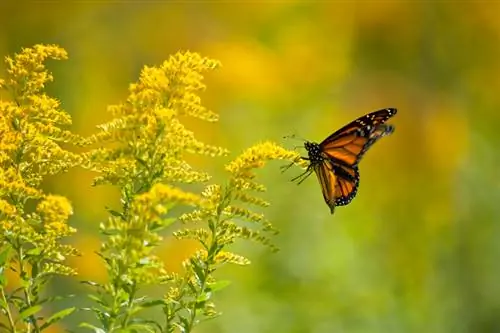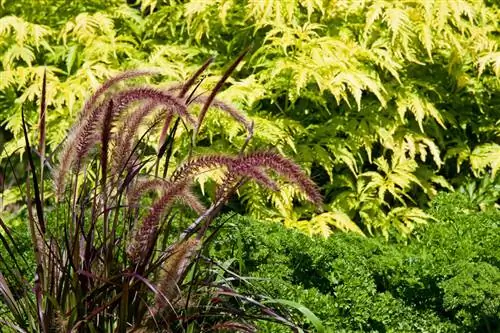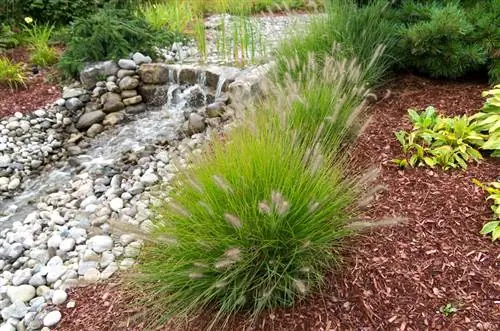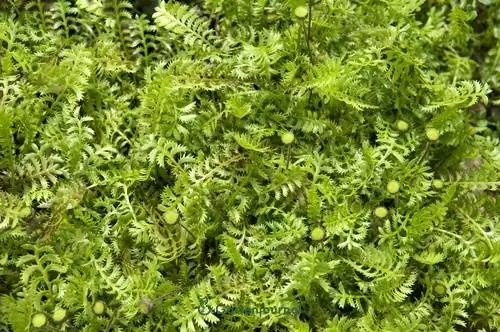- Author admin [email protected].
- Public 2023-12-25 17:45.
- Last modified 2025-01-23 11:21.
The feather bristle grass (bot. Pennisetum alopecuroides) has many names. Because of its cylindrical flower spikes, which are reminiscent of bottle brushes, the sweet grass is also known as pennisetum grass, and sometimes also as Australian pennisetum grass, given its origin. The herbaceous, hardy plant adorns flower beds, perennial borders and pots on terraces and balconies. With appropriate care, it looks attractive well into autumn.
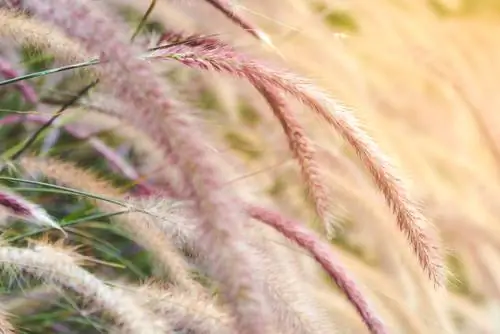
What is special about feather bristle grass?
The feather bristle grass (Pennisetum alopecuroides) is a hardy ornamental plant with arching, overhanging leaves and cylindrical flower spikes. It is suitable for beds, borders, container cultivation and in combination with other perennials. The plant needs a lot of sun and loose, permeable soil and can be propagated by division.
Origin and distribution
The feather bristle grass or pennisetum grass, as it is also called, belongs to the large family of sweet grasses (bot. Poaceae), and is originally native to the sunny plains of Australia. But the vigorous plant can also be found growing wild in East Asian countries such as China, Japan and Korea. The popular ornamental plant came to Europe very late, but quickly established itself after its introduction due to its high ornamental value and good frost tolerance.
The feather bristle grass (bot. Pennisetum alopecuroides) is one of around 80 other Pennisetum species, but of all of them the most widespread.
Usage
Pennisetum alopecuroides is suitable for both individual placement and group planting in beds and borders due to its vigorous growth and pretty flowers. Numerous perennial species are available as planting partners. The feather bristle grass is very suitable as a rose companion, but can also be easily combined with wild perennials or autumn bloomers. Attractive garden images are created, for example, by association with autumn asters, phlox, girl's eye, stonecrops, coneflowers, catnip or delphiniums. Furthermore, the feather bristle grass also goes well with low ground cover plants. Small varieties such as 'Hameln', 'Cassian' or 'Little Bunny' are also suitable for pot cultivation and decorate sunny terraces and balconies.
Appearance and growth
The perennial feather bristle grass develops a lush clump with arched, overhanging leaves, over which the delicate flower spikes appear from the late summer months onwards. The clump of leaves forms an almost perfect hemisphere and looks more like a bush than like a clump of grass. The species is about as tall as it is wide, with individual varieties such as 'Paul's Giant' reaching heights of up to 150 centimeters. Others, such as 'Little Bunny' or 'Little Honey', remain significantly smaller with an average height of around 30 centimeters. The species itself reaches heights of between 60 and 90 centimeters. The flower spikes are about 20 centimeters higher than the leaves.
leaves
The very narrow leaves of the feather bristle grass are a maximum of 12 millimeters wide. They are gray-green in color during the summer months, but usually turn golden yellow in the fall. Some varieties, such as 'Hameln' and 'Cassian', develop a particularly attractive autumn color that can be reddish to amber. The leaves of the Pennisetum grass still look very attractive in winter, but the new stalks do not sprout again until late in the spring.
Bloom and flowering time
The attractive flower spikes of the feather bristle grass are externally reminiscent of foxtails or small bottle brushes. Most varieties produce brownish to pink-red flowers that only appear in late summer and are a real feast for the eyes in beds or containers between August and October. Even in winter, the withered ears of corn still serve as decoration because the flowers do not decay straight away. However, this splendor only occurs after warm and sunny summers. If, on the other hand, the warm season is short, cold and / or rainy, the flowering period may be completely or partially canceled.
Toxicity
The feather bristle grass is not poisonous to humans or animals. However, caution is still advised as children playing on the hard stalks can easily cut themselves. Pets also run the risk of the grass getting stuck in the windpipe or injuring the internal mucous membranes. For this reason, ornamental grasses should only be planted or placed where curious children and hungry pets cannot reach them.
Which location is suitable?
The feather bristle grass needs a lot of sun and warmth, with daily sunlight exposure of at least four hours. The plant feels most comfortable in the southern areas of the garden, for example in open flower beds and borders without shadows from trees or walls. However, in locations that are too dark, the plant withers and usually dies quite quickly.
Floor
The feather bristle grass feels most comfortable in normal, loose garden soil, which may contain fine gravel or clay. The only important thing is that the subsoil is not compacted, but rather well permeable. If necessary, loosen the soil well and mix in gravel or sand. However, if the Pennisetum grass is cultivated in pots, it is best to plant it in normal potting or standard soil, which can be mixed with sand or gravel. Appropriate drainage is also important so that excess water can flow away and waterlogging does not occur in the first place.
Planting feather bristle grass correctly
When planting feather bristle grass, make sure that it can become quite large and extensive and therefore requires a lot of space. Maintain a planting distance of at least 60 to 80 centimeters from other garden plants and avoid a location with a lot of root pressure, for example from larger trees such as trees or hedges. This is not tolerated by the sensitive ornamental grass. The plant feels most comfortable in larger open spaces and in spacious rock gardens. The best time of year to plant feather bristle grass in the garden is spring.
Watering feather bristle grass
Potted plants should be watered regularly, while planted specimens should only be watered when necessary. This is the case, for example, in extreme drought and/or summer heat. Make sure that the feather bristle grass cannot tolerate waterlogging or permanently dry root balls. An indication of excessive dryness is often brownish discoloration on the leaf tips and stalks. In this case, you should water the plant in question heavily. If you stick to the following instructions, nothing can go wrong:
- Water potted plants before the upper substrate layer dries out.
- Use soft, low-lime water.
- Rainwater as well as filtered or stale tap water are well suited.
- Temper the water, because watering with cold water damages the feather bristle grass.
You should water the plants heavily, especially in the first few weeks after planting, to make rooting easier. The soil must not dry out during this time.
Fertilize feather bristle grass properly
Regular fertilization only makes sense for container specimens and for plants that have been established at the site for several years. Fertilization should be carried out especially during the energy-sapping flowering period, as the formation of the pretty flower spikes demands a lot from the plant. The following are particularly suitable fertilizers:
- liquid green plant or perennial fertilizer for potted grasses
- Compost soil or mature compost
- If you have a garden pond, simply use nutrient-rich pond water
- Bluegrain
Never apply fertilizer to dry soil, only to moistened soil. It is best to supply the plants with fertilizers dissolved in the irrigation water. Then the nutrients go straight to where they are needed.
Cutting feather bristle grass correctly
Cut the feather bristle grass about a hand's width above the ground in spring, this encourages new growth of fresh leaves. However, under no circumstances should you use scissors in autumn, as the long blades serve as winter protection. However, if they are too short, there is a risk of frost and rot damage.read more
Propagate feather bristle grass
The feather bristle grass tends to age after a few years, then only produces a few flowers and overall its growth no longer looks so lush. You can easily stimulate new growth by digging it up together with the rootstock, dividing it into several pieces and then replanting it separately.
Wintering
Most varieties of feather bristle grass are sufficiently hardy and can easily overwinter in the garden in protected locations. However, this does not apply to all varieties: Due to their lack of winter hardiness, some pennisetum grass should only be cultivated in pots and kept frost-free during the cold season. Other varieties, however, can stay outside, but need protective insulation, for example in the form of brushwood, straw or mulch. When attaching the protection, do not bend any stalks, as this weakens the plant and makes it more susceptible to diseases or pests. For this purpose, tie the stalks together.
Diseases and pests
With the right location and careful care, feather bristle grass is quite resistant to diseases and pests. It usually only becomes a problem when the location is permanently too wet or too dry; in both cases, fungal diseases can occur. Spider mites are also not uncommon in dry and warm locations.
Tip
The flowering stalks of the feather bristle grass can be cut off and used when dried to make attractive dry arrangements. But the long stalks also look good in autumnal flower arrangements or bouquets.
Species and varieties
The feather bristle grass comes in various wild species, which are usually larger than the cultivated varieties. In addition to the species Pennisetum alopecuroides, the taller and pink-flowering Pennisetum orientale (also known as “fine feather bristle grass”) is also often planted in gardens. The selection of the variety should be based on the intended use and the available space. Small-growing and non-hardy ornamental grasses can also be cultivated in pots, while the larger varieties are better off in the garden bed.
The most beautiful varieties of feather bristle grass:
- 'Cassian': growth height up to 100 centimeters, light brown flower spikes
- 'Compressum': growth height up to 100 centimeters, yellow-brown flower spikes
- 'Hameln': growth height up to approx. 50 centimeters, brown-red flower spikes, early flowering from the beginning of summer
- 'Autumn magic': growth height up to 80 centimeters, yellow-brown flower panicles
- 'Little Bunny': also dwarf pennisetum, growth height between ten and 30 centimeters
- 'Moudry': growth height up to 50 centimeters, violet to almost black false flowers
- 'Red Hed': growth height up to 90 centimeters, pink to brown flower spikes between July and October


